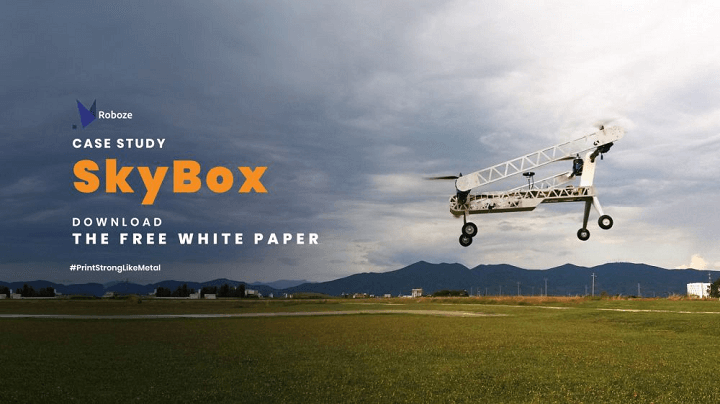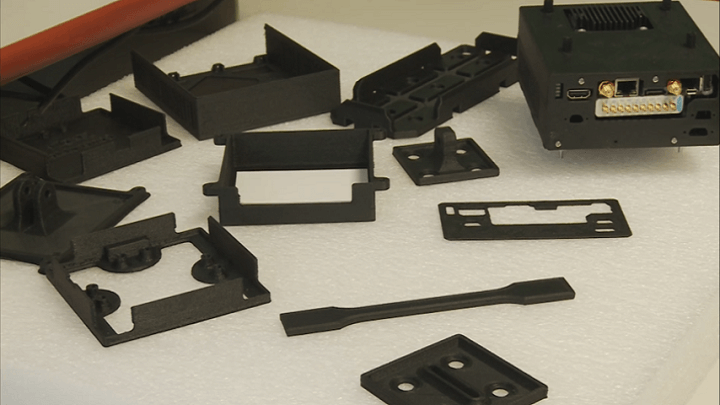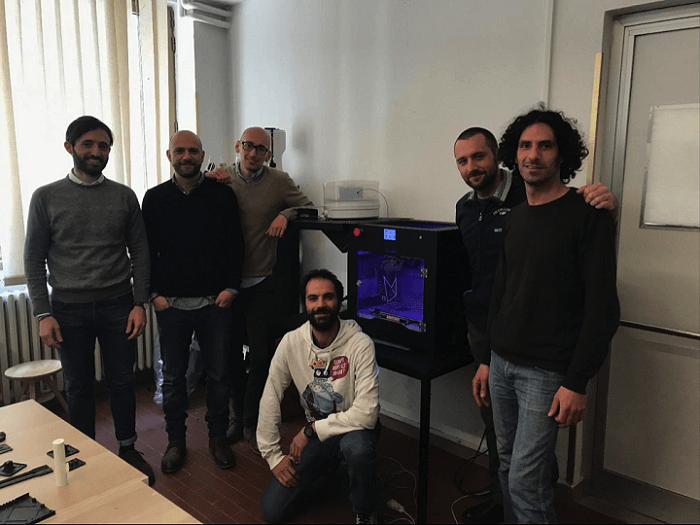Founded in 2009, SkyBox Engineering s.r.l. is a spin-off company from the University of Pisa that’s focused on research and development in the aeronautics industry. As Italian 3D printer manufacturer Roboze explains in a new case study and whitepaper, the company is using its FFF 3D printing technology to create functional aero model parts for the “drones of the future.”
Roboze 3D printing solutions are designed to create long-lasting, repeatable, and resistant parts for multiple industries, including oil & gas, motorsports, defense, aerospace, and aeronautic. The company uses a variety of high quality thermoplastic, composite, and high temperature materials, and its patented Beltless System, to make functional prototypes and final parts for multiple applications, including professional, industrial, and extreme.
“The necessity of using 3D printing results from the nature of our projects. The main goal is the reduction of weights and encumbrances of the parts that are positioned on drones and aero models, getting advantage of the possibility to build functional parts with even complex shape,” explained Vincenzo Binante, Engineer at SkyBox.
“Roboze is the first 3D printing solution adopted by SkyBox, in the past we used to ask an external service to realize parts, printed with this technology. We chose Roboze for the quality of the material and the chance to test different printing processes: moreover, Roboze solution allows to have a protected and controlled build plate with a good precision and to get confident with the printer extremely quickly.”
Customers using Roboze technology enjoy multiple benefits for their projects, such as accessibility, flexibility, and precision. The SkyBox team needed to create a system of dampers that would insulate a drone’s autopilot from high frequency vibrations that result from its motors. Using Roboze technology, SkyBox created a 3D printed housing – with a 25% reduction in weight – that was “equipped with dampers,” and also quickly modified the housing’s joint.
 This solution would not have been possible if the team had used conventional machining tools and aluminum; instead, it used Roboze’s carbon fiber filled polyamide material, Carbon PA, which has been used for similar applications in the past. Carbon PA is a high performance technical material, with a 138MPa tensile strength, and is often used for the 3D printing of finished parts for metal replacement applications – something that has advantages which Roboze is capable of combining with those of additive manufacturing.
This solution would not have been possible if the team had used conventional machining tools and aluminum; instead, it used Roboze’s carbon fiber filled polyamide material, Carbon PA, which has been used for similar applications in the past. Carbon PA is a high performance technical material, with a 138MPa tensile strength, and is often used for the 3D printing of finished parts for metal replacement applications – something that has advantages which Roboze is capable of combining with those of additive manufacturing.
“When the application does not allow to use plastics, it is possible to realize cheap mockup very quickly, with the aim of doing assembly tests, before producing the part: this permits to have more accessible development costs, with a time saving of 20% and weight saving of 25%,” said Binante.
Using polymers, rather than metal materials, in industrial sectors like aerospace, manufacturing, motorsports, and oil & gas, can help lower the weight of parts, in addition to providing better workability. Other benefits include low friction coefficient, electrical insulation, and a chemical resistance to corrosion.
AM solutions by Roboze are meant to cover multiple lead-time phases of products. Because of its versatile, high-performance materials, guaranteed repeatability, and Beltless System, the Bari-based company can produce parts with 25-micron mechanical tolerances; this allows its customers, like SkyBox, to create concept parts, functional prototypes, and finished parts that are ready for assembly.
Binante said, “The Roboze solution permitted to definitely speed up the prototyping process, as allows a more direct transfer from the CAD model to the realization of the part, compared to the traditional manufacturing methods.”
To learn more about the collaboration between Roboze and SkyBox, you can download the whitepaper here.
Discuss this story and other 3D printing topics at 3DPrintBoard.com or share your thoughts in the Facebook comments below.
[Images provided by Roboze]Subscribe to Our Email Newsletter
Stay up-to-date on all the latest news from the 3D printing industry and receive information and offers from third party vendors.
You May Also Like
3D Printing Unpeeled: New Arkema Material for HP, Saddle and Macro MEMS
A new Arkema material for MJF is said to reduce costs per part by up to 25% and have an 85% reusability ratio. HP 3D HR PA 12 S has been...
3D Printing News Briefs, January 20, 2024: FDM, LPBF, Underwater 3D Printer, Racing, & More
We’re starting off with a process certification in today’s 3D Printing News Briefs, and then moving on to research about solute trapping, laser powder bed fusion, and then moving on...
3D Printing Webinar and Event Roundup: December 3, 2023
We’ve got plenty of events and webinars coming up for you this week! Quickparts is having a Manufacturing Roadshow, America Makes is holding a Member Town Hall, Stratafest makes two...
Formnext 2023 Day Three: Slam Dunk
I’m high—high on trade show. I’ve met numerous new faces and reconnected with old friends, creating an absolutely wonderful atmosphere. The excitement is palpable over several emerging developments. The high...


































